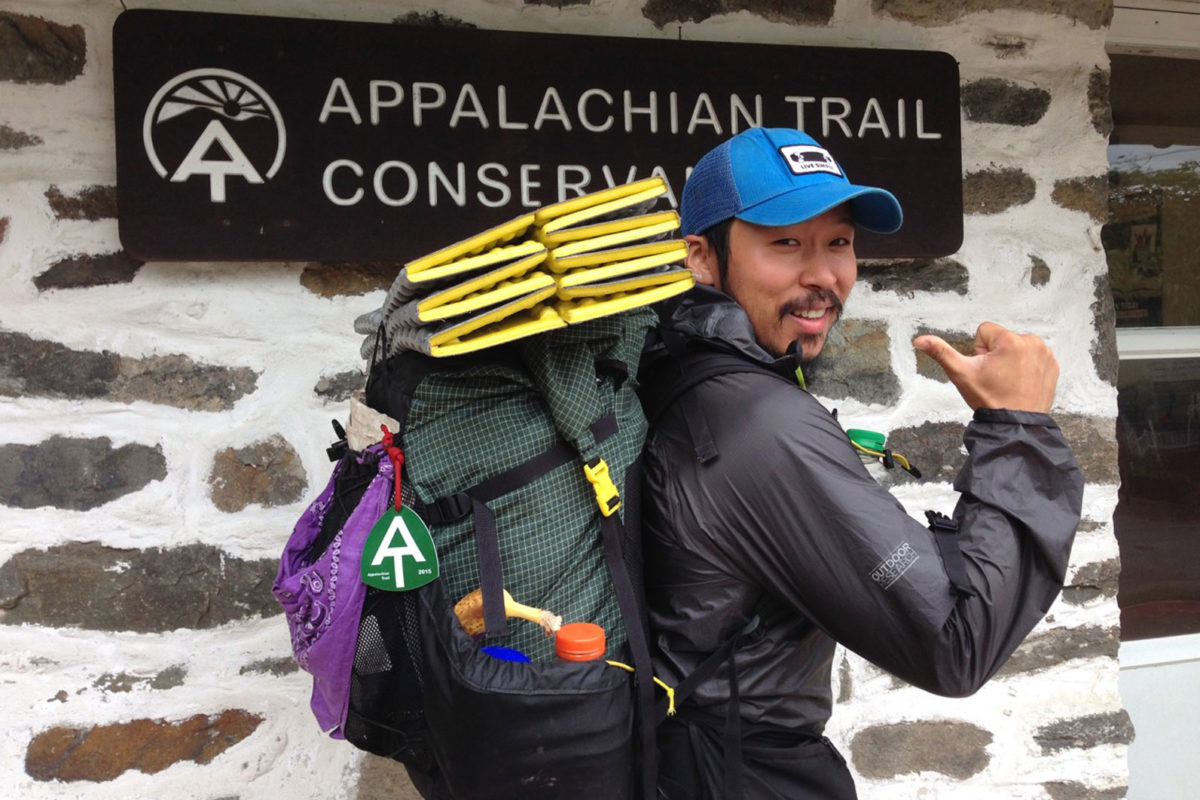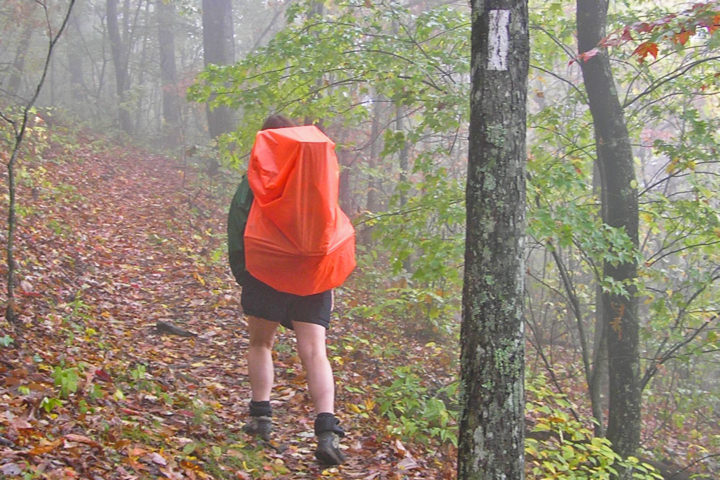Thru-Hiking
Flip-Flop Thru-Hikes
Flip-flop thru-hikes
Flip-flop thru-hikes can offer benefits like milder weather, a longer time frame to complete the Trail, and moderate terrain in which to start. Flip-flop thru-hikes also help conserve the Trail by reducing overcrowding and sustaining communities along the Trail.
Scenarios below outline sample alternative itineraries for a six and one-half month “flip-flop” thru-hike, with tips for those seeking hikes of shorter or longer duration.
Below are some suggested flip-flop thru-hike itineraries.
Harpers Ferry, West Virginia, Start
Harpers Ferry, North to Katahdin; Harpers Ferry, South to Springer
Mid-April to Mid-May Start
This is a great option for college students who can’t begin their hikes until late spring and those who want to avoid the crowds. It also allows for the longest window of mild weather. Start in Harpers Ferry and reach Katahdin in August; return to Harpers Ferry around Labor Day; finish at Springer Mountain, Georgia in November.
We advise not starting northbound from Harpers Ferry before about April 15, as weather conditions with such an early start can be unfavorable through much of the northern leg of the journey, and there will be virtually no other long-distance hikers on this part of the Trail. Faster hikers should start later or further south than Harpers Ferry so as not to reach Vermont before mud season (which ends Memorial Day) or New Hampshire when snow or snowmelt can make conditions treacherous.
The ideal time to return to Harpers Ferry to complete the second leg is the end of August or early September, when the early southbounders are starting to arrive. This will also minimize time spent hiking in high heat and humidity; northern Virginia is extremely hot and humid in August. Slower hikers who want to avoid the prolonged cold at the southern end of the hike may choose to begin sooner, however.
The Harpers Ferry Start thru-hiker can expect:
- Avoiding the crowds of Georgia-starting thru-hikers, overflowing shelters, campsites, and hostels.
- Experiencing cool weather to start (chance of snow is negligible if waiting until after the first week of April), walking north with spring wildflowers.
- Beginning with the area of least elevation change along the A.T. but encountering increasingly rocky terrain through the first 300 miles (hard on knees carrying extra weight, with old injuries or inadequate strengthening).
- Encountering short but steep climbs (requiring the use of your hands) just over 200 miles into your hike.
- Hiking the Mid-Atlantic before it gets hot, humid and water sources become scarce.
- Reaching the White Mountains in July, before peak crowds.
- Reaching Maine in late July/August, when black flies are gone and lakes are warm enough to enjoy swimming.
- Plenty of time to reach Katahdin in Maine before it closes in mid-October.
- Walking south with fall colors on the second half of your hike in late September and October.
- Trees will be bare by end of October except at the lowest elevations, potentially making the forests less interesting but opening up more views.
- Companionship with early northbounders the first half, then finishing with southbounders.
- Hiking through the fall hunting season, requiring extra caution and displaying blaze orange.
- Cold nights and cold-weather gear needed starting in October, with the possibility of snow or ice starting at the end of October, especially in the Smokies.
- November is often consistently cold (temperatures may stay below freezing for multiple days) with rapidly shortening daylight hours and light snowfall a possibility in higher elevations.
- December is even colder, the chance of deeper snowfall is greater, and nights are very long.
Recommendations/Considerations
This style flip-flop hits the sweet spot between crowds and aloneness, reduces exposure to extremes of weather, and starts in one of the prettiest and easiest-to-get-to spots on the Trail. If you start earlier than May, make sure you do not reach Vermont before mud season ends (Memorial Day weekend).
Read articles by flip-flopper “Spice” (note: link opens PDF file) about her experiences and tips for future flip-floppers.
A Word of Caution
On the first leg of this itinerary, do not expect to keep pace right away with thru-hikers who started in Georgia; allow yourself 6-8 weeks or more to get in optimal shape. Pushing your body beyond its limits to keep up with other hikers may result in an injury that ends your hike. (On the other hand, you will likely find yourself in prime shape for the most difficult parts of the Trail: New Hampshire and Maine — before months of long miles and a diet that is likely deficient take their toll).
Faster hikers who finish the first half at Katahdin in early August may want to plan a break and return to Harpers Ferry at the end of August or the beginning of September. This will minimize time spent in the summer heat and humidity and offer companionship from more southbound thru-hikers.
Slower hikers should return to Harpers Ferry as soon as possible to minimize the time spent in cold weather in the high mountains of the Southeast. This will mean the first few weeks in northern Virginia will be hot and humid and there will be very few long-distance hikers on this part of the Trail, but temperatures will cool fairly quickly and southbounders will catch up with you.
Shenandoah Start
Shenandoah National Park North to Katahdin; Shenandoah National Park, Va., South to Springer
April Start
Beginning in Shenandoah National Park is a great option for those who want more time to complete a thru-hike. It is also a good plan for those who want to start on some of the A.T.’s least difficult terrain. However, starting in April means starting in cold weather (temperatures below freezing are not uncommon, especially earlier in the month).
Road access here is more frequent and amenities are located at closer intervals than anywhere else (except from November through the first week of April, when facilities are closed). This itinerary also allows you to avoid crowds. Begin in Shenandoah National Park the second week of April or later, hike north to climb Katahdin mid-August, resume hiking south the third week of August, finish on Springer Mountain in early November. Be sure to check the Shenandoah National Park facility schedule; you’ll want to wait until the waysides (places to gets meals, snacks, and limited resupply) restaurants, and other amenities are open.
This Shenandoah Start thru-hiker can expect:
- Cold weather in April, with a chance of snow or flurries the first two weeks; expect temperatures below freezing until leaving the higher elevations of Shenandoah National Park.
- Bare trees (still dormant in winter conditions) at higher elevations to start.
- Starting in the terrain of moderate difficulty (many ups and downs, but more gradual than the southern mountains, less rocky than north of Harpers Ferry, West Virginia).
- Plentiful amenities along the trail to start, especially in the central section of Shenandoah National Park.
- Chance to build up your “trail legs” before reaching the rocky sections of Pennsylvania and the climbs that require the use of hands.
- Plenty of time to reach Katahdin before it closes in mid-October.
- Enjoy fall colors in the Southeast.
A Word of Caution
Shenandoah National Park is one of the most accessible sections of the entire A.T. most of the year, but when snow falls, Skyline Drive closes and the park becomes one of the more inaccessible sections. If snow falls in April, it usually doesn’t last long. The last closure of “The Drive” often occurs in March, but can sometimes be the first or second week of April, and infrequently, the third week or later.
On the first leg of this itinerary, do not expect to keep pace right away with thru-hikers who started in Georgia; allow yourself 4-8 weeks or more to get in optimal shape.
Pawling, New York, Start
Pawling North to Katahdin; Pawling South to Springer
June Start from Pawling, New York
Start at the Appalachian Trail Stop (or nearby Pawling on weekdays) in June and hike northbound, climbing Katahdin mid-August. Resume south from the starting point in New York with the southbound thru-hikers, finishing the end of November
This Head Start thru-hiker can expect:
- Avoiding the crowded shelters and the “spring break” atmosphere of the early part of a northbound hike.
- Following autumn for much of the southbound portion of the hike.
- The opportunity to approach Katahdin head-on, one of the most exciting sights on the A.T.
Recommendations/Considerations
Public transportation is available weekends to the Appalachian Trail Stop in New York near the Connecticut border via the Metro-North railroad line (between Pawling and Wingdale). More information is available on the ATC shuttle and public transportation list at www.appalachiantrail.org/transportation.
Georgia "Late Start" Flip-Flop
Springer Mountain North to Harpers Ferry, W.V.; Katahdin South to Harpers Ferry.
Mid-April to early May Start
Start at Springer Mountain after April 15 and hike north, reaching Harpers Ferry, W.V. in the middle of July; then flip to Katahdin and hike south to Harpers Ferry, ending in the first half of November.
This Late-Starting Flip-Flop thru-hiker can expect:
- Starting at Springer Mountain behind the crowds of thru-hikers.
- Minimizing chances of snow or severe cold the entire hike.
- Avoiding heat in most of mid-Atlantic.
- Not worrying about reaching Katahdin in Baxter before it closes in mid-October.
- Hiking with late northbounders first half; hiking with southbounders the second half and meeting northbounders a second time.
- Hiking south with fall colors.
A Word of Caution
Advance campground reservations are required at Baxter State Park (you are not eligible to use The Birches Long-Distance Hikers site).
"The Leapfrog"
Springer Mountain North to Harpers Ferry, W.V.; Southern New England North to Katahdin; Southern New England South to Harpers Ferry
Mid to Late-April Start
Start at Springer Mountain during the second half of April and hike north with late northbounders, reaching Harpers Ferry in the middle of July; “leapfrog” to Great Barrington, Massachusetts, hiking north with early northbounders to Katahdin by September. Return to Great Barrington and hike south to Harpers Ferry with late southbounders/
A leapfrog thru-hiker can expect:
- Starting at Springer Mountain behind most northbounders.
- Minimizing chances of snow or severe cold the entire hike.
- Avoiding the worst heat in most of the mid-Atlantic and hiking in New England before severe cold sets in.
- Walking north toward Katahdin with little or no time pressure.
- Hiking through southern New England and Mid-Atlantic in fall colors.
Recommendations/Considerations
Additional travel logistics and expenses are required.
Modified "Cool Breeze"
Hike the Trail in three sections. Start with the middle third of the Trail southbound, followed by the northern third northbound, ending with the southern third southbound.
Late-April Start
Start in Pawling or Bear Mountain New York in late April, hike south until reaching Troutville (Roanoke area), VA in late June. Hike north from New York to Katahdin, arriving in August/early September. Hike south from Troutville, ending at Springer in early November.
A cool breeze thru-hiker can expect:
- Hiking in mid-Atlantic during spring, before it gets hot and water sources become scarce.
- Hiking in moderately difficult terrain for the first two months.
- Hiking in New England after bug season, in temperate weather before it gets cold.
- Few other long-distance hikers traveling the same direction, especially on the first leg.
- Not worrying about Katahdin closing in mid-October.
- Avoiding extremes of both heat and cold.
- Additional travel logistics.
Recommendations/Considerations
This option is especially attractive to hikers from the New York/Connecticut area who want to start their thru-hike close to home.
A Word of Caution
Few hikers follow this pattern; you will have a lot of solitude in the beginning. It works best for hikers who are couples or those who are hiking with partners.
Southbound Circuit (aka "Wraparound")
Harpers Ferry, W.V. to Springer Mountain; Katahdin to Harpers Ferry
Mid-April Start
Start in Harpers Ferry the second or third week of April and hike south, reaching Georgia the first half of July. Flip to Katahdin and hike south, finishing in Harpers Ferry the second half of October.
A southbound wrap-around thru-hiker can expect:
- Avoiding snow and ice if starting after March.
- Avoiding bugs and most of the summer heat.
- Some, but not all seasonal services in Shenandoah National Park.
- Passing through and meeting almost all of the northbound thru-hikers in May.
- Experiencing a great deal of solitude.
- Starting in mostly moderate terrain the first six weeks.
- Enjoying rhododendron, mountain laurel, and azalea in bloom in the south.
- Hot, humid weather in Georgia.
- Not worrying about reaching Katahdin in time.
- Walking south with southbounders and fall foliage.
Recommendations/Considerations
The first leg of this hike is somewhat challenging; the first day begins with a fairly steep, thousand-foot climb out of Harpers Ferry and seventeen miles later, a section endearingly referred to as the “Roller Coaster.”
Consider staying at Skyland Lodge in Shenandoah National Park, so you can use it as a mail drop and cut the food you have to carry through the Park in half while you’re still getting in shape.
Harpers Ferry has direct train access.
A Word of Caution
This version is not strongly encouraged, as it could lead to additional crowding when those walking south pass through the northbound crowds. Advance camping reservations are required at Baxter State Park- you are not eligible to use The Birches Long-Distance Hikers campsite.

A.T. Hangtags
Hangtags distributed by the Appalachian Trail Conservancy (ATC) are frequently seen dangling off an aspiring 2,000-miler’s pack, marking their intent to traverse the entire Appalachian Trail (A.T.).
Discover More

Plan and Prepare
Hiker Resource Library
A collection of resources for hikers to stay safe, healthy, and responsible on the Appalachian Trail.

Plan and Prepare
Thru-Hiking
Thru-hiking the A.T. is the adventure of a lifetime. But trekking the 2,190+ miles of the A.T. is no easy feat — make sure you’re prepared!

Plan and Prepare
Safety
Learn about the hazards you may face when hiking the Appalachian Trail and how to avoid or prepare for them is the best way to stay safe.
